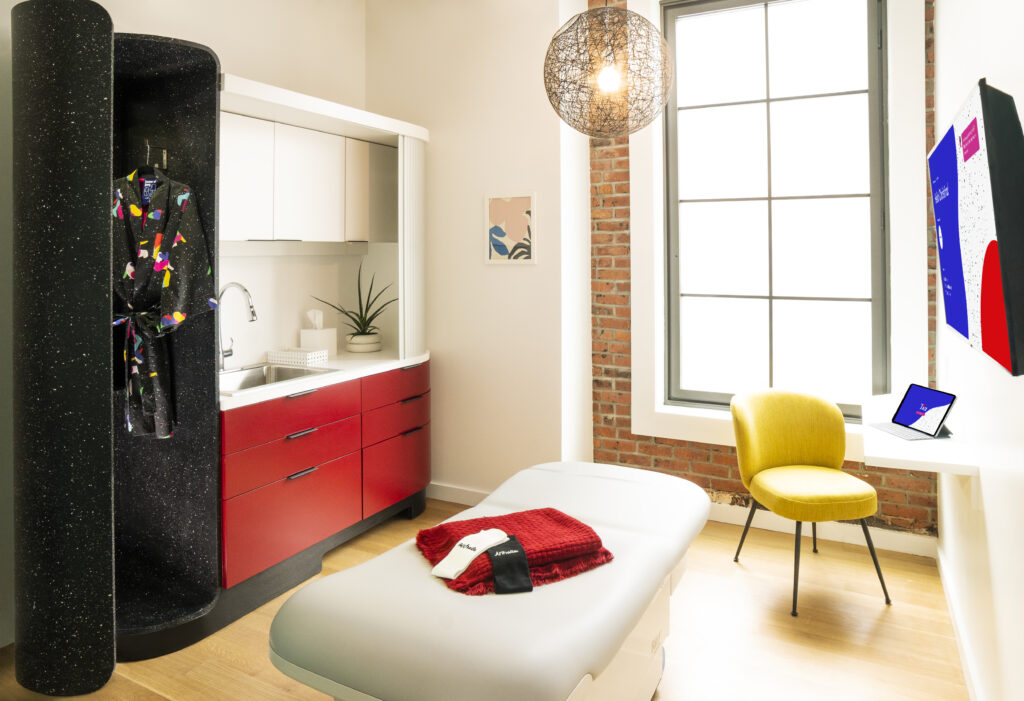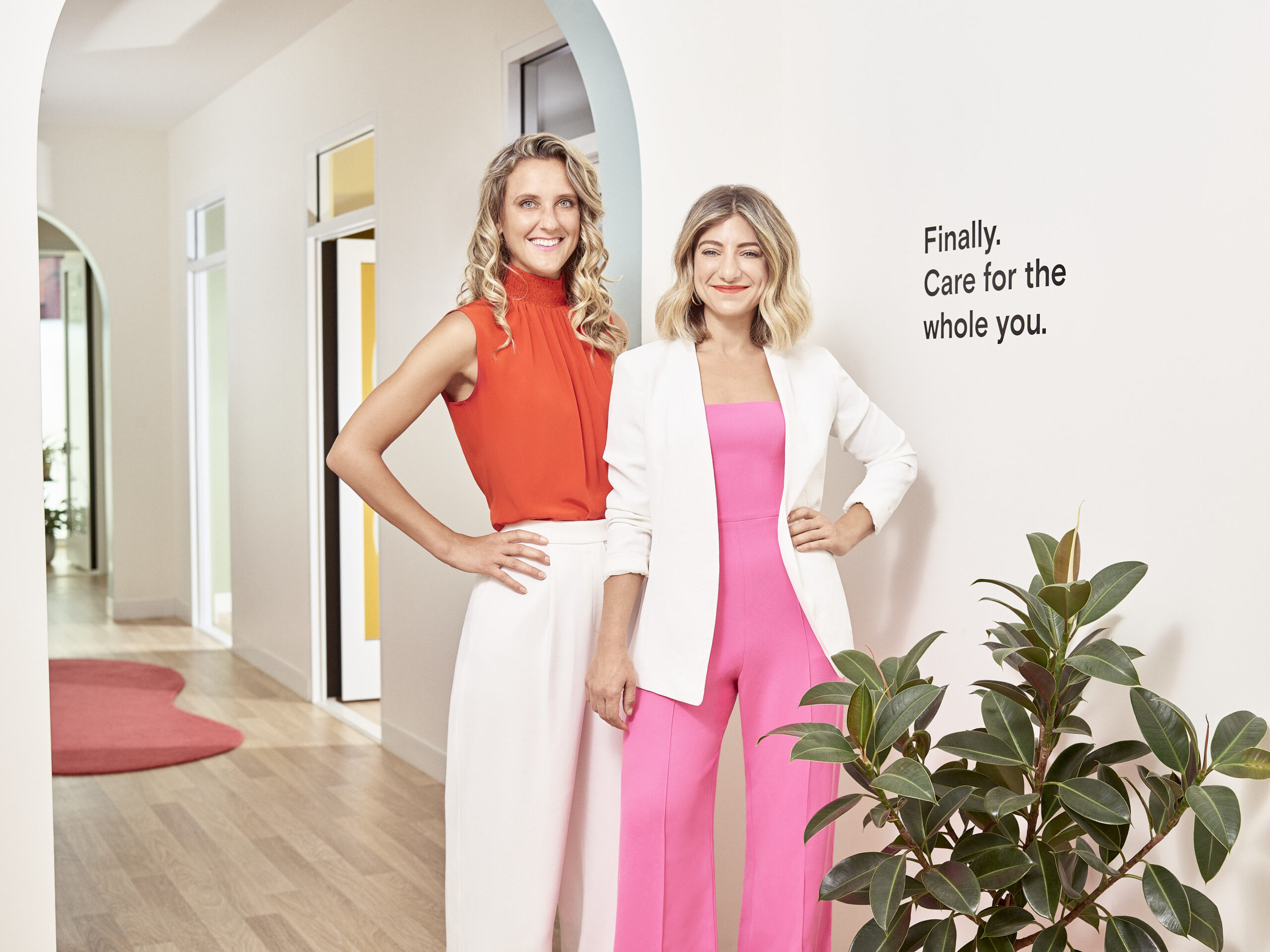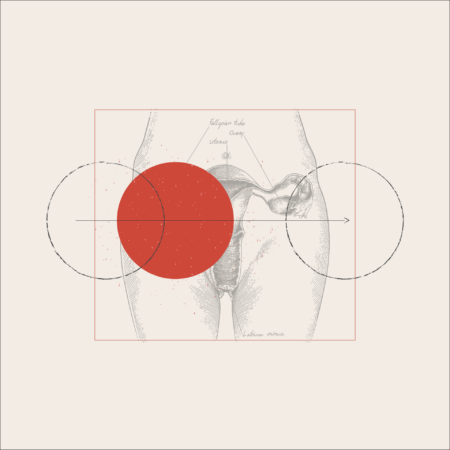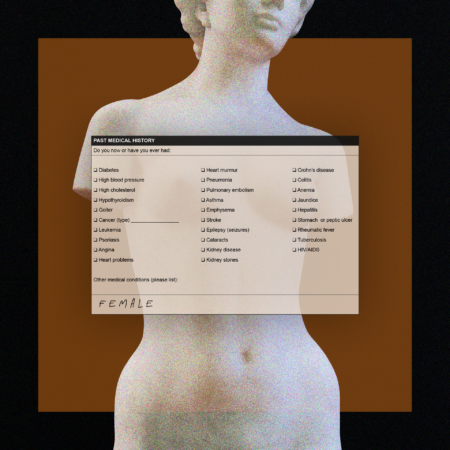Carolyn Witte was a Team Lead at Google Creative Labs when she started experiencing hormone-related health symptoms. She had gone off birth control but hadn’t gotten her period; “instead,” she wrote in a post on Medium back in 2017, “I experienced a sudden onset of intense cystic acne and extreme mood swings.” She visited gynecologists, dermatologists, and other specialists who were able to treat the symptoms but couldn’t diagnose the problem. Three years later she still faced dead ends, so she turned to the internet and diagnosed herself: she had polycystic ovarian syndrome (PCOS). A visit to a fertility specialist—covered, luckily, by Google’s robust health insurance—confirmed she was right.
The experience opened her eyes to a broken, compartmentalized health care system that failed to connect the dots, especially when it came to women’s health. Witte began reimagining healthcare for women, exploring what it could look like if it incorporated technology similar to the products she was building at Google—despite having no prior experience in the medical field, startups, or financing. But she saw an opportunity. The women’s health industry and “fem-tech” (VC jargon for startups relating to female bodies) was blowing up. And Witte was 25, the perfect age to take a big risk. “I was in a fortunate position to be young and not have a huge amount of financial responsibility with respect to a mortgage or kids,” Witte says. “I kind of thought, ‘If Tia fails, I can come back to Google. It will be okay.’ And that is a very privileged place to be.”
We needed to build a full-stack model. The initial business model that I picked was not the right one.
She sold some Google stock and put her life savings, a personal investment of $50,000, into exploring and developing the first iteration of Tia, a chat-based assistant app that helped users answer questions about birth control and sexual health. She contracted an engineer to help her build it. She interviewed dozens of women about their health care needs. She had coffee with anyone willing to teach her about healthcare, insurance companies, and “care models,” a term she had never heard before. Eventually, she quit Google, moved back to San Francisco and into an apartment with her best friend from Cornell, Felicity Yost. Witte worked at their dining table for six months, exploring Tia’s possible directions while Yost was at work. One day, Yost told her: “I don’t want to go to my job anymore. I just want to talk about Tia.” Yost became her co-founder.
Witte and Yost raised a Pre-Seed angel round in May 2017 of $500,000. One of those angels was Halle Tecco, CEO of Natalist and co-founder of the digital health-focused seed fund Rock Health. “We moved from having individuals we knew writing us $10,000 checks, to [Tecco], an angel investor who gave us credibility far greater than the check size that [she wrote],” recalls Witte. Tecco, a longtime champion of female founders in women’s health, told Witte: “‘I don’t know exactly what Tia is all about, but I know you’re going to figure it out. You have something here. You have a brand that makes women feel a certain way.’” Tecco’s reputation and investment in Tia gave Witte and Yost a big stamp of approval. She introduced them to other investors and helped bring them into the VC spotlight.
Tia launched its consumer app in June 2017. Within 90 days, thanks largely to Instagram marketing, they had over 10,000 users, many of whom Witte and Yost chatted with themselves. “It was like a faucet,” says Witte. “We’d post an ad, acquire a bunch of users, turn the ads off, answer all of their questions, then post another ad, and acquire a bunch more users. At a peak, we were having 3,000 conversations a day. We called them ‘wing-woman’ hours from 8 a.m. to 11 p.m., then we’d have sleeping hours and you’d get a ‘We’re getting some beauty sleep, we’ll answer your question in the morning’ away message.” Tia users began bringing the app with them to doctors’ appointments, securing themselves with the information they gleaned on Tia in case their doctors disagreed. It was popular, even if it wasn’t yet generating income. “I thought, ‘Hey, it’s growing,’” says Witte. “‘We have a hot thing. Let’s go raise money.’”

They raised their Seed round of $2.5 million in September 2017, two and a half months after their app launched. With capital raised, Witte felt pressure to build Tia quickly. “The clock really starts ticking,” Witte says. Tia was no longer Witte and Yost exploring its possibilities at their dining table. Now they had investors and a board who wanted to see returns, even though the app was nascent. Still, its user base continued to grow. “We had over 200,000 one-on-one conversations,” Witte remembers. “It was a very strong indicator of product-market fit, so we invested very quickly to try to scale the team to be able to support the growing volume.” They hired three engineers, a part-time designer, and health educators to help answer users’ questions.
Tia still didn’t have a reliable revenue model, however, and the app alone couldn’t fix the broken healthcare system. Witte knew that users were “hacking” the app by bringing it to their doctors, and—lightbulb moment!—realized that Tia itself should provide the care its users were seeking. In December 2017, three months after closing their Seed round, Witte decided to pivot the direction of the company to include a brick-and-mortar women’s health clinic. “I had an aha moment of, ‘Holy shit,’” she recalls. “‘We need to build a full-stack model. The initial business model that I picked is not the right one.’” Building a clinic was a bigger and costlier vision, one that was not covered by their $2.5 million Seed round. So in 2018, they raised a bridge round, this time of $3.5 million (of which The Helm invested). “The bridge round essentially filled in the financial gap, giving us the ability to open the physical space and hire doctors,” explains Witte. “Building out a clinic takes twice as long and costs three times as much as you believe it’s going to.”
Pivoting is expensive. Witte already had a team on payroll, employees with salaries and benefits. “It’s really expensive to just breathe,” Witte says of running a newly-funded startup. “To pay for rent, office space, to have employees. We weren’t big, but we had employees and an office and all these [costs], and then we changed our business pretty substantially.” They let go of some of the new hires as the company changed course. “That was a hard decision,” Witte recalls, “but an important one to make from both a financial perspective and a prioritization perspective.”

Sign up for a Tia Membership
Tia membership unlocks access to virtual & in-clinic whole-person healthcare, unlimited messaging and more.
Witte cautions against raising money too early, advising prospective CEOs to wait until they have a clear business model before raising capital. “[We] probably raised our first institutional round earlier than we should have,” she says. “I was naïve. I had this false illusion around entrepreneurship that allowed me to jump out of the airplane blindly in a way that I don’t think, in hindsight, I would probably have done the same way.” Delaying fundraising gives CEOs more freedom to iterate, to make the necessary mistakes every CEO must make, she says, but Witte had another glaring reality to face: she needed to raise VC money to pay herself a salary. She couldn’t afford to keep working on Tia without getting paid.
The Tia Clinic gave Witte the business model she needed. When it opened in March 2019 in the Flatiron district of New York City, 800 members joined within the first month, each paying an annual membership of $150 before having their insurance pay for their services. Members had their clinic profiles synced to their Tia app and made appointments with the Tia team of integrated healthcare providers—doctors, acupuncturists, and nutritionists all working together to provide patient care, a true one-stop-shop for women’s comprehensive healthcare. Revenues from memberships and well-woman exams poured in. Member interest was so high that Witte and Yost had to slow down their acceptance of new patients while they scaled up their in-person medical team. A year after opening, they had over 3,500 members. The full-stack model was a success. “We had amazing data that it was really working on many fronts, from a consumer perspective, from a provider perspective, from an economic perspective,” Witte says.
The numbers gave her the confidence to keep scaling and go for her Series A, using the Tia Clinic as “a very expensive but important concept store” that proved her vision of integrated women’s care, both in-person via the clinic and online via the app. She was certain that the numbers would guarantee her more funding, and she was right, but the fundraising wasn’t as easy as she imagined. She began to raise her Series A just after the demise of WeWork, and investors, especially those in the digital health industry, were hesitant to back brick-and-mortar companies. “Series A is different,” Witte says. “They’re no longer just investing in you. They’re investing in your business.”
To investors, though, Witte’s model—the modern medical home for women in the United States—had created a clear line to becoming a multi-billion dollar business. By March 2020 she had raised $24 million, the largest amount a woman in the U.S. raised that year, closing her Series A right as the coronavirus hit New York. She signed the term sheet before COVID-19 tore through the city, but Witte was still nervous that the upheaval of the pandemic would cause investors to back out. “The time between the signed term sheet and money in the bank is a very uncomfortable period,” she recalls. “You can’t really take a deep breath.” Aside from fundraising, she was running a healthcare clinic during a public health crisis, with employees to pay and keep safe, and 3,500 patients to keep healthy.

Their Series A came with new investors, a new board, and new expectations to meet, all while trying to navigate the uncertain landscape of a city in emergency. Though the Tia Clinic was an essential service, Witte and Yost, along with their Chief Medical Officer, Dr. Stephanie McLellan, decided to close the clinic to protect staff and patients. “We closed our Series A the day we closed the physical Tia Clinic and launched virtual care,” recalls Witte. Once insurers allowed reimbursements for tele-health visits, virtual care—which was not included in their original Series A business model—protected staff and provided new revenue opportunities while their in-person services remained closed. Patients no longer needed to come into the clinic to refill their birth control.
Tia provided as many online health services as possible while the city unraveled. “And then,” Witte recalls, “we saw a 400 percent increase in behavioral health-related messages on our platform.” Patients reeling from the chaos and uncertainty of COVID flooded the Tia app with messages about panic attacks and anxiety. So Tia launched virtual behavioral healthcare, providing patients with online therapy sessions and access to prescriptions. It has been a successful extension to their original care model in the wake of the pandemic; a quick response to the needs of the Tia patient, brining 33 full-time therapists on staff by mid 2021.
With services temporarily but completely online, Witte was forced to consider laying off some of her clinic staff but ultimately decided not to go through with any layoffs or furloughs. Instead, she cut costs at the corporate level, such as marketing, which allowed Tia the wiggle room to keep everyone on payroll. “We were able to make a decision that felt in line with our core values and the needs of our team and of our customer base,” Witte says. “And I say that with a huge amount of compassion for all of the founders and CEOs who had to do these harsh layoffs. It’s a really difficult decision that people have to make.”
The Clinic reopened on June 1, when New York City was at its height of Black Lives Matter protests. “We had no dull moments in 2020,” Witte jokes. Tia had to balance temperature checks and COVID tests and safety protocols while protests surged in Flatiron. “Everything around the Tia Clinic was looted every single day,” Witte recalls. The staff already had anxiety about returning to work and were even more hesitant to come during the protests. “We had a lot of curfews and we had safety issues.”
It took us nine months to raise our Series A. It took us three weeks to raise our Series B.
Witte has since doubled down on Tia’s virtually-integrated online/offline model of care: app and clinic, tele-health, and in-person visits. “In many ways, our business is stronger coming out of COVID than it was before,” she says “We’ve always said Tia is a comprehensive women’s care, and this integrated model broadens our mandate.” With $24 million in the bank, Witte expanded the Tia Clinic to new markets, opening Los Angeles and Phoenix-based locations in March with a San Francisco flagship that includes obstetric care, hired two new VPs responsible for scaling the company, and then quickly turned around to raise one of the largest Series B rounds ever for a healthcare company focused on women. Signaling that women’s health is shifting from “niche” to mass market, Tia raised $100 million in August, of which The Helm invested follow-on capital, bringing the company’s total funding to $132 million.
“It’s was such a radically different experience and a big shift,” admits Witte of raising the Series B round. “It took us nine months to raise our Series A. It took us three weeks to raise our Series B. I’ve been saying the same thing for the last four years, and this was the first time everyone got it. Suddenly, people just understood what we were doing and why it mattered.” Tia now has an all-female board, “which is very unique and cool,” she says. “But more importantly, we have a mix of really amazing healthcare investors who happen to be women—it’s an important distinction.”
Next year, Tia will open 15 new clinics both within its existing markets (Los Angeles, New York, Phoenix, and the Bay Area) and a yet-to-be-announced fifth market which will enable Tia to be “the mass market women’s healthcare brand available to women everywhere,” says Witte, whose goal is to serve 100,000 women by the end of 2023. “We are building healthcare that just works—it’s as simple as ‘I’m a woman, I have a need, I turn to Tia,'” she says. “Currently women’s healthcare is confusing. Women are Googling ‘I have anxiety, where do I find a psychiatrist or a therapist? I have pelvic pain, do I go to my OB/GYN or reproductive endocrinologist? I have migraines, is that a primary care doctor issue or a headache doctor issue?’ We’re shifting that thought process to: ‘I have a need, I turn to Tia to take care of the rest.’ We are scaling a ‘whole-woman, whole-life’ healthcare model, where Tia simply means healthcare for more than 50 percent of the population.”
It’s been a windy road to get here, Witte admits. For all the capital she raised, she insists that fundraising isn’t—and shouldn’t be—the ultimate barometer for a successful venture. Instead, a CEO will find success by listening to what her customers want, and what they are willing, and unwilling, to pay for. “You need to know that as a founder,” Witte says. “And until you know that, be as cautious as you can possibly be with spending. Whether it’s your own money or other people’s money.” As for how the definiton of her role as co-founder “with perfectionist tendencies” has changed from Seed to Series B, the biggest shift has been removing herself from the weeds and figuring out how to take a step back. “My job is to paint the picture of the why, and maybe a little bit of the what, but not the how. I used to be the why, what, and the how. Now I’m hyper focused on figuring out whether our what should change because the world changed.” The most important thing for a founder is making sure you have enough space to think about where the world is going, Witte advises. “We made a lot of big bets, oftentimes against our investors, that we had conviction around that we couldn’t prove with data. And now we’re scaling this to women everywhere.”
Carolyn Witte Answers 5 Financial Questions on Founding a Business
1. What do you regret spending money on in the early days?
It’s funny. I think founders are really, really cheap about certain things, like crazy cheap, and then spend too much money on other things. I would put myself in that bucket probably. I would go through periods of being maniacal about every penny that was spent and looking for every work-around way to save $10, but that’s not really productive. The job of the CEO is to make sure your company has money. That’s your one really important job. But in the early days, you’re also typically responsible for figuring out product-market fit, so if you’re just the penny counter and not focusing on building your product, that’s a problem. It’s finding a balance of that. We had to stretch our money really far. Felicity and I used to rent our apartment in San Francisco on Airbnb to go to New York; we would share a bed for three months without air conditioning. We were just trying to do everything ourselves and we were so exhausted. We had nobody. We were trying to extend our runway another month, and another month, and it was really hard. I don’t necessarily know if I would do them differently, they’re like the war wounds and the trenches that you get from building a company that we laugh at now. But they’re the cost of building a company and being scrappy.
2. What do you wish you spent more money on?
I wish we had spent more on experts and senior hires earlier on. We kind of thought, “We can figure it out. We can figure out real estate. We can figure out insurance. We can figure out these really hard things about our business that we knew nothing about.” And we convinced ourselves that we didn’t have the cash to pay someone else who knew much more about these things than we did to figure them out for us. That ultimately cost us more money.
3. What was your hiring strategy?
Our first three hires were engineers, then we hired health educators who built out our platform and interface with our users, and helped answer questions that women were messaging to Tia. We had to scale that team very fast. This thing was blowing up and it was creating a lot of pressure, so we invested very quickly to try to scale this team to support the growing volume, which is a very logical decision. And it was working, but the business, for other reasons, was going in a different direction. Ultimately, we had to make the decision to pull the plug on that entirely because we couldn’t afford to keep it going while we figured Tia out. That was a really hard decision, but an important one to make from a both financial perspective and a prioritization perspective, which I think a lot of companies struggle with in the early days. You can only really do one thing well at most, and we tried to do a lot of things well.
4. How did you break into the world of health and VC while building Tia?
You just hustle. One lesson for first-time founders—whether you’re a woman or not—is curiosity goes a long way. If you can create space to meet people and learn and not ask them for money in the same conversation, it’s a lot easier. And that’s really hard when you really need money, but in the early days, particularly if you’re entering a really complex industry you don’t know a lot about, which is what I did, that “I just want to talk to you and learn and not ask you for money” goes a long way.
5. What’s the biggest lesson you’ve learned as a founder?
So much of starting a company is out of your control, which as a control freak, in retrospect, I ultimately found to be very humbling. The job of the CEO and the founder is to respond, to see behind corners, to control what you can control and respond to all the things that you can’t control. Timing is a huge thing that you don’t control, which is so critical to fundraising as well. The only thing you do control is how you react to the world, which is really the lesson of COVID, is this thing happened, it changed every company’s business, especially healthcare businesses. Most people thought it would kill Tia’s business, but we came out stronger than before it. How you react, and making sure I have the space to think about how to react and see around corners, is increasingly a large part of my job.






